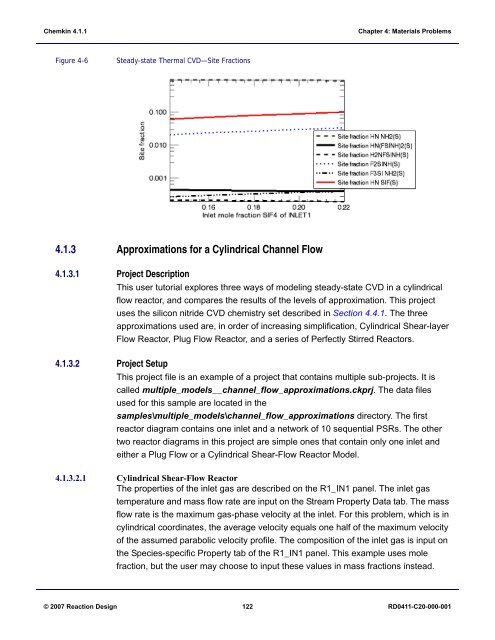Tutorials Manual
Tutorials Manual
Tutorials Manual
You also want an ePaper? Increase the reach of your titles
YUMPU automatically turns print PDFs into web optimized ePapers that Google loves.
Chemkin 4.1.1<br />
Chapter 4: Materials Problems<br />
Figure 4-6<br />
Steady-state Thermal CVD—Site Fractions<br />
4.1.3 Approximations for a Cylindrical Channel Flow<br />
4.1.3.1 Project Description<br />
This user tutorial explores three ways of modeling steady-state CVD in a cylindrical<br />
flow reactor, and compares the results of the levels of approximation. This project<br />
uses the silicon nitride CVD chemistry set described in Section 4.4.1. The three<br />
approximations used are, in order of increasing simplification, Cylindrical Shear-layer<br />
Flow Reactor, Plug Flow Reactor, and a series of Perfectly Stirred Reactors.<br />
4.1.3.2 Project Setup<br />
This project file is an example of a project that contains multiple sub-projects. It is<br />
called multiple_models__channel_flow_approximations.ckprj. The data files<br />
used for this sample are located in the<br />
samples\multiple_models\channel_flow_approximations directory. The first<br />
reactor diagram contains one inlet and a network of 10 sequential PSRs. The other<br />
two reactor diagrams in this project are simple ones that contain only one inlet and<br />
either a Plug Flow or a Cylindrical Shear-Flow Reactor Model.<br />
4.1.3.2.1 Cylindrical Shear-Flow Reactor<br />
The properties of the inlet gas are described on the R1_IN1 panel. The inlet gas<br />
temperature and mass flow rate are input on the Stream Property Data tab. The mass<br />
flow rate is the maximum gas-phase velocity at the inlet. For this problem, which is in<br />
cylindrical coordinates, the average velocity equals one half of the maximum velocity<br />
of the assumed parabolic velocity profile. The composition of the inlet gas is input on<br />
the Species-specific Property tab of the R1_IN1 panel. This example uses mole<br />
fraction, but the user may choose to input these values in mass fractions instead.<br />
© 2007 Reaction Design 122 RD0411-C20-000-001
















